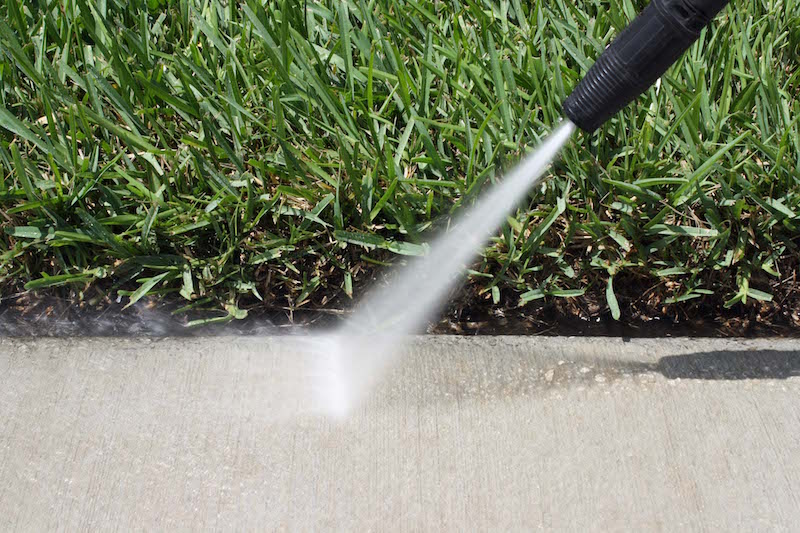To maintain the value and appeal of concrete surfaces, power washing is the way to go. A power washer, also known as a pressure washer, is the most efficient way to clean large concrete surfaces, and is very user friendly. A power washer will handily deal with tough stains, such as those caused by paint, chemicals, and tire marks. In this blog, we’re going to cover everything you need to know to give your concrete the clean it needs, including:
- What you should look for in a power washer
- How to power wash your surface
- Runoff disposal
- Maintenance
What You Should Look for in a Power Washer
You’ll need a power washer that can operate at a pressure of at least 3000psi, with a water flow rate of at least 15 litres per minute. Whilst you may require slightly higher pressure to deal with the hardiest stains out there, it’s generally agreed that 3000psi will more than cover the requirements of most jobs.
We also recommend the use of a rotary nozzle to increase the speed of your clean. Rotary nozzles spin the jettisoned water in a circular pattern, offering drastic speed increases when compared to standard fan nozzles, which deflect water at an angle, sapping exit velocity.
If you’re washing a large area, you may wish to consider using a wheel-mounted power washer. These machines are quite large, and whilst a little more expensive than regular power washer, can be up to 3 times as efficient.
How to Power Wash Your Surface
We’re going to break down this process into 3 basic steps, one of which is optional.
Step One: Surface Preparation
Before you begin utilising your power washer, you best make sure the surface is properly prepared—this will save you bucket loads of time in the long run.
- First, make sure to remove all obstacles, including debris, furniture, potted plants and toys.
- If you have a delicate garden that may be in the firing line, it’s best to cover the selected areas with a non-porous material like a tarpaulin.
- If you cannot remove certain electrical items, such as electrical outlets and electrical wires, make sure they are securely covered. Plastic or water-proof tape will do the trick.
- If your surface is partially covered with heavy amounts of oil or grease, it’s best to remove this first using a tri-sodium phosphate based product.
Step Two: Apply Detergent
This step is optional, and depends on the state of your concrete surface. After a significant period of usage, however, a pressure wash aided by detergent is always a good idea for maximum cleaning results.
- Before applying detergent as per manufacturer’s instructions, it’s a good idea to give your surface a light wash with your power washer to remove residual clumped debris. This will allow for a more thorough application of detergent.
- After you apply the detergent, allow it so settle for at least 5 – 10 minutes.
Step Three: Power Wash
Now comes the fun part. Once your detergent has had a chance to break down some of the tougher stains and grime, you can crank your power up and start blasting. As mentioned above, a rotary nozzle attachment to your power washer will increase the speed and the ease of the washing process.
Once you’ve managed to rid your concrete of the tough stains, it’s time to rinse away the remaining detergent. You may wish to switch back to a fan nozzle for this procedure, so as to be more gentle with the surrounding area. Your concrete surface should now be wonderfully clean!
Runoff Disposal
Depending on the nature of the surface you’re cleaning and the detergent used, you may have to take certain precautions with the disposal of your runoff water. If the process of power washing has removed certain environmentally harmful chemicals from the concrete surface, for example, it may be illegal to allow water runoff to enter the sewer system. Depending on your location and the precise nature of the chemicals involved, you may have to dispose of your runoff at a waste-disposal location.
Maintenance
Maintaining your power washer is an often overlooked practice. Because power washers operate at such high pressure, wear and tear over time is unavoidable. However, by taking note of the following, you can get a whole lot more usage from your machine.
- Do not run your machine without water available.
- Don’t leave your washer running for more than a few minutes without triggering water release. The water circulating the valve or your machine will heat up quickly, and can damage your washer.
- Make sure that your power washer’s water volume requirements are met by the water source. If your water source is too weak for your machine, your power washer will start to suck in air, which can cause internal damage.





